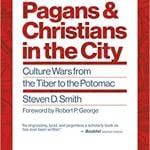Steve D. Smith
Pagans & Christians in the City: Culture Wars from the Tiber to the Potomac
Grand Rapids, MI: Eerdmans, 2018.
Available at Eerdmans and Koorong.
This is definitely one of the more interesting books I’ve read of late. Smith’s basic thesis is that paganism never really went away and today’s cultural wars are really just a rehash of the old pagan vs. Christian debates. The contest is between those who say that sum of all value and meaning is immanent (pagans) and those who say it is transcendent (Christians). In his own words:
Pagan religion locates the sacred within this world. In that way, paganism can consecrate the world from within this world: it is religiosity relative to an immanent sacred. Judaism and Christianity, by contrast, reflect a transcendent religiosity; they placed the sacred, ultimately outside the world – beyond time and space” (112).
The strength of this book is its knowledge of classical antiquity and correlating ancient discussions with modern debates about religion and the public square.
Following Douglas Laycock, Smith points out that the problem with the culture war today is that “Each side wants a total win” (p. 7). No peace, no tolerance, no place for the other. Either a return to Christendom or its obliteration.
Smith notes how pagan cities were highly sexualized, able to cater for any and every sexual need: “And the city maintains numerous, much-frequented brothels. In these establishments, sex is eminently affordable – about the price of a loaf of bread” (54). Also: “Thus, in Roman cities, brothels dotted the cityscape like Starbucks or Taco Bells in a modern American city” (77). Quoting Kyle Harper’s observation: “the Roman Empire was the most complete and most refined expression of a sexual economy that had its origins in the birth of the classical Mediterranean city-state. If the disciplines of sexual self-knowledge were more rigorous in the high empire, the delivery of sexual pleasures was more efficient than ever” (78).
There is a great quote from Keith Hopkins about two-time travelers reporting just how god-saturated the pagan cities were: “There were temples and Gods, and humans praying to them, all over the place: at the entrance to the town, at the entrance to the Forum; there were altars at the crossroads, Gods in the riches as you went along, with passersby just casually blowing a kiss with their hands to the statue of a God set in a wall. And of course, here in the Forum, the ceremonial center of the town, there were temples, altars, Gods, heroes just about everywhere we looked. … Our end of the square was filled by the grand Temple to Jupiter, with Vesuvius magnificently snowcapped behind. And all the rest of the buildings looked as though they could be temples too” (69-90). Then, quoting Robin Lane Fox, it is noted that the gods “were not simply up in heaven, but rather were all around – in the storm, in sickness, in battle, in the public spaces, in dreams, in stories” (80). Ancient cities, then, did not believe in gods but spoke of “having gods” (83).
There is good stuff on how paganism was not actually tolerant and a thesis argued that the west was never really and completely de-paganized.
Probably the best argument for the book is Anthony T. Kronman’s book Confessions of a Born Again Pagan that describes his drift from cultural marxism to a kind of neo-pagan philosophy that divinizes nature.
Anyway, a very stimulating read, of relevance to anyone interested in religion in antiquity and modern conflicts over sex, politics, and religion in culture.












